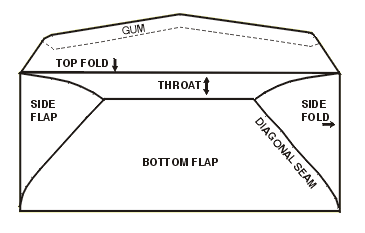Fundraising Envelope Glossary of Terms
Refer to the glossary below for additional terms to help you select the perfect envelope for your specific application. Below is a diagram of a commercial #10 diagonal seam envelope.  BANG-TAIL: Perforated coupon attached to the body of a return envelope; must be torn off before the envelope is sealed. Used for remittance envelopes and other direct mail applications.
BANG-TAIL: Perforated coupon attached to the body of a return envelope; must be torn off before the envelope is sealed. Used for remittance envelopes and other direct mail applications.
BARCODE: Pre-printed code used for electronic postal scanning.: Generated by postal service for OCR scanners. Location on the envelope is critical for proper barcode scanning.
BARONIAL: A style of envelope that has a large pointed seal flap. Baronial style envelope is usually close to being square; however, the flap and paper used are the most distinguishing feature. The most common present usage is for greeting cards or social stationery.
BLEED: An image that extends off the page or envelope. Envelopes with bleed should be printed before they are folded.
BOOKLET: Envelopes with the “open side” flap, open on the long side of the envelope
BUSINESS REPLY or RETURN ENVELOPE: These two envelopes can be any style or size. The distinct difference between them is, who pays the postage. A Business Reply is referred to as the envelope that has a pre-printed First-Class Permit and return address on it and the original sender pays for its return. The business Return has a pre-printed return address but the individual returning the envelope must apply postage. The most commonly used envelope for either purpose is commercial #6-3/4 or #9. Another frequently used style is the remittance flap which serves as both the mailing and the return envelope.
CATALOG: All envelopes with the “open end” flap are called catalog.
CENTER SEAM: Is the permanent seam that is located approximately in the center of the envelope running from the bottom fold up through the envelope and terminates at the throat.
COMMERCIAL STYLE: These are the most common business style envelopes. They are “open side” of the diagonal or side seam construction. Applies to a wide range of sizes both regular and window envelopes.
CORNER CARD: Return address and other company identification in the top left corner.
DIAGONAL SEAM: A seam running diagonally from the bottom fold and the corner up toward the throat of an envelope.
FACE: The front of the envelope.
FLAPS EXTENDED: This term is used to describe leaving the flap in a vertical position (not folded down).
FLAPS FOLDED DOWN: A term to describe folding the flaps down against the back of the envelope. Most envelopes are packed in boxes with the flaps folded down.
FULL VIEW PICTURE WINDOW: Large window envelope that allows full view inside of the contents of the envelope.
INSIDE TINT: Printed design on the inside of the envelope for added security.
LATEX SEAL: Is a self-sealing adhesive that requires no moisture. Two gum surfaces are required to create a bond when they are brought together.
OPEN END: A style of envelope on which the opening is on the short side. All open end envelopes are called catalog or coin envelopes.
OPEN SIDE: A style of envelope on which the opening is on the long side. All commercial envelopes are called open side.
REGULAR: A style of commercial envelope that does not have a window panel in it.
REMITTANCE: A large style seal flap of approximately the same size and shape of the envelope itself.
SIDE SEAM: Is an envelope seam that runs along the side almost parallel to the side fold.
ZIP STICK: Is a self-sealing adhesive with a protective strip. No moistening is required.
